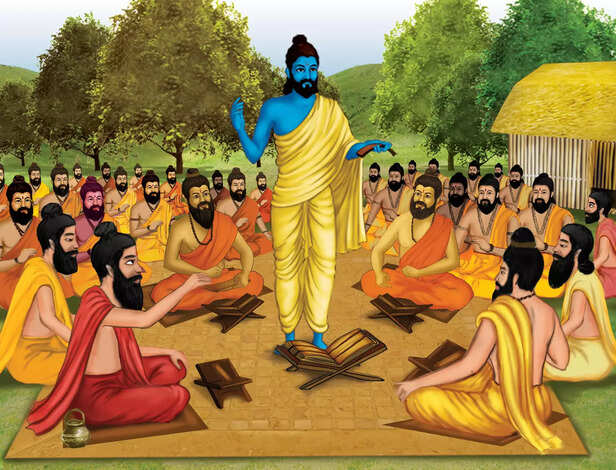The Silent Grace of Saraswati—Realizing Wisdom, Not Memorizing Words
Ankit Gupta | Jun 04, 2025, 23:59 IST
True vidya (knowledge) is not rote learning or intellectual accumulation. It is anubhava — direct experience, inner realization. Just as fire is known not by description but by warmth, knowledge is understood through presence and clarity, not by recitation. Goddess Saraswati, the embodiment of wisdom, music, and speech, doesn’t dwell in restless intellects who chase applause. She graces the sthita prajna — those whose hearts are calm, minds silent, and egos quiet. In stillness, she reveals herself.
"Knowledge is not memorized – it is realized. Saraswati sits with the still-hearted, not the loud-minded."
In the modern cacophony of debates, declarations, and data dumps, it is easy to forget that wisdom is not found in volume but in vācya — the essence behind the word. Saraswati, the white-robed goddess seated on a lotus with a veena in hand, is often misunderstood as the deity of mere learning. But in truth, she is the goddess of realized wisdom — not just stored information. She is the spirit that animates silence, the clarity that dawns in the absence of noise. To know Saraswati is to realize that the mind must quiet down for the soul to speak.
In the Rig Veda, she is described as:
“Saraswati na vahed vājinīvatī dhīnāṁ avitrī yajatāṁ”
(May Saraswati, the inspirer of true knowledge and wisdom, flow richly for the one performing the sacred inner sacrifice.)
This is not the Saraswati of schoolbooks or syllabi — it is the Saraswati who awakens in dhyana (meditative contemplation). Loud minds — filled with pride, distraction, or craving for recognition — cannot hold her. She slips away like a swan, landing only in the calm lake of a still heart.

India’s ancient rishis did not “study” the Vedas. They heard them — Shruti. The sound arose not from outside but within the deep cave of their silence. This is aparoksha anubhuti — direct experience, not second-hand information. This is why the Upanishads boldly claim:
“Yato vāco nivartante aprāpya manasā saha”
(That from which words return, not having attained it — along with the mind.)
The highest truth cannot be spoken. It must be realized.
Modern education often focuses on memorization — exams, grades, IQ, achievements. But ancient wisdom traditions placed emphasis on transformation. Memorization builds a scholar; realization builds a sage. One can recite hundreds of shlokas and still remain arrogant, restless, and ego-bound. But one moment of genuine inner silence, and Saraswati reveals what no scripture can fully explain.
This is echoed in the Kena Upanishad:
“Yasya amatam tasya matam, yasya matam tasya na veda.”
(He who thinks he knows, does not know. He who knows he does not know, knows.)
Knowledge that rests on the ego is false. Real knowledge begins with surrender.

In mythology, Saraswati rides a hamsa — a swan. But this is not just a bird. The hamsa is the symbol of viveka — discrimination between truth and illusion. It is said that the swan can separate milk from water. So too must the spiritual seeker separate wisdom from noise, truth from belief, experience from memory.
The still-hearted are those who no longer chase applause. Their joy is in inner clarity, not outer confirmation. They are not swayed by the latest trend or loudest voice. They listen deeply — to themselves, to others, to the universe. It is in their silent presence that Saraswati blossoms.
Such was the heart of Nachiketa in the Katha Upanishad, who sat in silent tapasya, waiting to receive true knowledge from Yama, the god of death. He didn’t beg, debate, or boast. He waited. Still. Silent. Unshaken.
And in that stillness, the knowledge of immortality was revealed to him — not taught, but awakened.
The loud-minded, however, are like the crow chasing its echo. No matter how hard they speak, they only hear themselves. The more they seek to dominate, the less Saraswati flows.

There’s a striking irony in Indian philosophy — that the deepest truths are remembered, not learned. This is the idea behind “Smriti” and “Jñāna” — that the soul already knows. What we call "learning" is often just remembrance of our eternal nature.
This is why meditation is emphasized. In meditation, the noisy surface of the mind settles, and the deep knowing of the soul rises. The eternal truths — Aham Brahmasmi, Tat Tvam Asi, Sarvam Khalvidam Brahma — are not intellectual ideas. They are echoes of your own being, waiting for the silence to be heard again.
Saraswati is not impressed by data or degrees. She is moved by devotion, silence, purity, and deep introspection.
This principle is beautifully illustrated in the life of Sri Ramana Maharshi. He had little formal education. Yet, at the age of 16, he attained Atma Jnana — the realization of the Self — not through study, but through direct deathlike inquiry. He never “memorized” the scriptures. He became them.

How does one invite Saraswati into their life?
Not by shouting mantras without feeling.
Not by debating Vedanta with a restless mind.
Not by showing off how much one knows.
But by becoming humble, quiet, present, and devoted.
Saraswati’s abode is not a noisy temple, but the silent shrine of the heart. When the storm of desires settle, and the winds of ego fall still — she appears.
This is the secret of the Gayatri Mantra, her supreme expression. It does not ask for wealth, power, or victory. It simply asks:
“Dhiyo yo nah prachodayāt”
(May she illuminate our intellect.)
Even the prayer is silent, inward, and humble. It doesn’t command. It surrenders.
Saraswati is not an achievement. She is grace. She descends when the seeker ascends within. She does not argue; she reveals. She does not shout; she whispers in silence. She does not come with pride; she arrives with purity.
The modern world chases “knowledge” as quantity. How much do you know? How many books have you read? How many degrees have you earned?
But Saraswati smiles quietly — because true knowledge cannot be counted. It can only be lived.
Her truest form is Mouna — the silence of knowing, beyond all words.
Her purest sound is Nada — the unstruck music of consciousness.
Her deepest temple is Antahkarana — the purified inner instrument of awareness.
Let the mind shout — and she disappears.
Let the heart still — and she arrives.
The Goddess of Silence, Not Sound
In the Rig Veda, she is described as:
“Saraswati na vahed vājinīvatī dhīnāṁ avitrī yajatāṁ”
(May Saraswati, the inspirer of true knowledge and wisdom, flow richly for the one performing the sacred inner sacrifice.)
This is not the Saraswati of schoolbooks or syllabi — it is the Saraswati who awakens in dhyana (meditative contemplation). Loud minds — filled with pride, distraction, or craving for recognition — cannot hold her. She slips away like a swan, landing only in the calm lake of a still heart.
Realization Over Memorization

The Eternal Vedic Principle
India’s ancient rishis did not “study” the Vedas. They heard them — Shruti. The sound arose not from outside but within the deep cave of their silence. This is aparoksha anubhuti — direct experience, not second-hand information. This is why the Upanishads boldly claim:
“Yato vāco nivartante aprāpya manasā saha”
(That from which words return, not having attained it — along with the mind.)
The highest truth cannot be spoken. It must be realized.
Modern education often focuses on memorization — exams, grades, IQ, achievements. But ancient wisdom traditions placed emphasis on transformation. Memorization builds a scholar; realization builds a sage. One can recite hundreds of shlokas and still remain arrogant, restless, and ego-bound. But one moment of genuine inner silence, and Saraswati reveals what no scripture can fully explain.
This is echoed in the Kena Upanishad:
“Yasya amatam tasya matam, yasya matam tasya na veda.”
(He who thinks he knows, does not know. He who knows he does not know, knows.)
Knowledge that rests on the ego is false. Real knowledge begins with surrender.
Saraswati’s True Devotees

The Still-Hearted
In mythology, Saraswati rides a hamsa — a swan. But this is not just a bird. The hamsa is the symbol of viveka — discrimination between truth and illusion. It is said that the swan can separate milk from water. So too must the spiritual seeker separate wisdom from noise, truth from belief, experience from memory.
The still-hearted are those who no longer chase applause. Their joy is in inner clarity, not outer confirmation. They are not swayed by the latest trend or loudest voice. They listen deeply — to themselves, to others, to the universe. It is in their silent presence that Saraswati blossoms.
Such was the heart of Nachiketa in the Katha Upanishad, who sat in silent tapasya, waiting to receive true knowledge from Yama, the god of death. He didn’t beg, debate, or boast. He waited. Still. Silent. Unshaken.
And in that stillness, the knowledge of immortality was revealed to him — not taught, but awakened.
The loud-minded, however, are like the crow chasing its echo. No matter how hard they speak, they only hear themselves. The more they seek to dominate, the less Saraswati flows.
Knowledge is Remembered Only When It Is Realized

The Still-Hearted
There’s a striking irony in Indian philosophy — that the deepest truths are remembered, not learned. This is the idea behind “Smriti” and “Jñāna” — that the soul already knows. What we call "learning" is often just remembrance of our eternal nature.
This is why meditation is emphasized. In meditation, the noisy surface of the mind settles, and the deep knowing of the soul rises. The eternal truths — Aham Brahmasmi, Tat Tvam Asi, Sarvam Khalvidam Brahma — are not intellectual ideas. They are echoes of your own being, waiting for the silence to be heard again.
Saraswati is not impressed by data or degrees. She is moved by devotion, silence, purity, and deep introspection.
This principle is beautifully illustrated in the life of Sri Ramana Maharshi. He had little formal education. Yet, at the age of 16, he attained Atma Jnana — the realization of the Self — not through study, but through direct deathlike inquiry. He never “memorized” the scriptures. He became them.
The Way to Saraswati

Silence, Surrender, Stillness
( Image credit : Freepik )
How does one invite Saraswati into their life?
Not by shouting mantras without feeling.
Not by debating Vedanta with a restless mind.
Not by showing off how much one knows.
But by becoming humble, quiet, present, and devoted.
Saraswati’s abode is not a noisy temple, but the silent shrine of the heart. When the storm of desires settle, and the winds of ego fall still — she appears.
This is the secret of the Gayatri Mantra, her supreme expression. It does not ask for wealth, power, or victory. It simply asks:
“Dhiyo yo nah prachodayāt”
(May she illuminate our intellect.)
Even the prayer is silent, inward, and humble. It doesn’t command. It surrenders.
Saraswati is not an achievement. She is grace. She descends when the seeker ascends within. She does not argue; she reveals. She does not shout; she whispers in silence. She does not come with pride; she arrives with purity.
In the End, All Knowledge is Silence
But Saraswati smiles quietly — because true knowledge cannot be counted. It can only be lived.
Her truest form is Mouna — the silence of knowing, beyond all words.
Her purest sound is Nada — the unstruck music of consciousness.
Her deepest temple is Antahkarana — the purified inner instrument of awareness.
Let the mind shout — and she disappears.
Let the heart still — and she arrives.
